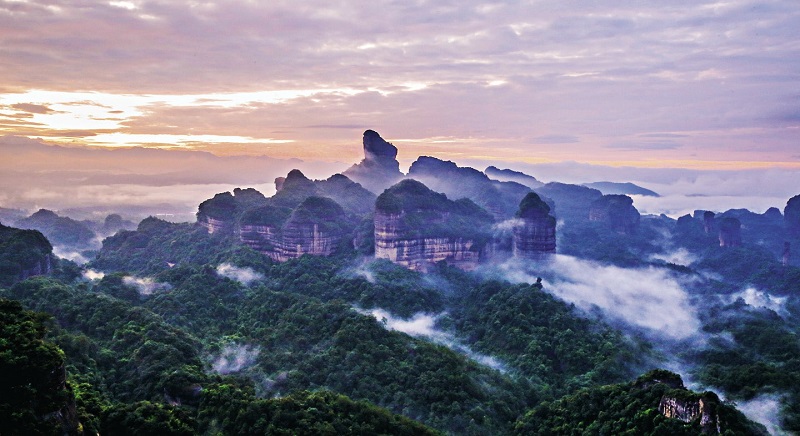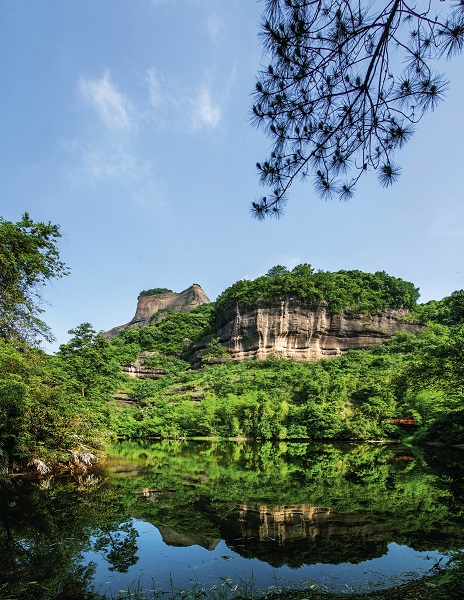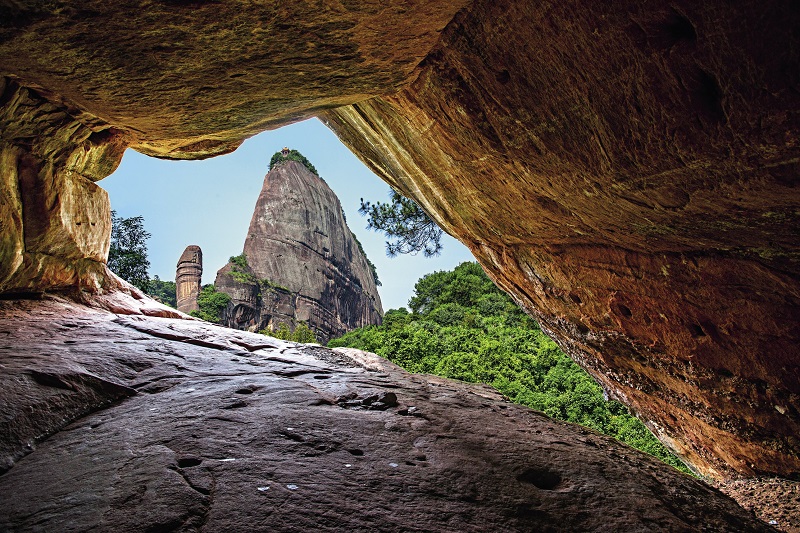A signature landform showcases the magic of nature.

A stunning view of daylight pouring into the Danxia Mountain in Shaoguan of Guangdong Province on July 8, 2018.
Covering 292 square kilometers, the Danxia Mountain, also known as the “Red Rock Park,” is located in the northeastern suburb of Shaoguan City in south China’s Guangdong Province. It is a 5A-rated state-level tourist attraction, a national scenic spot and a national nature reserve. It was included in the World Heritage List of the United Nations Educational, Scientific and Cultural Organization in 2010. Its unique Danxia landform is one of the most beautiful geological wonders in the world, while the unique landscapes, red sandstone rocks, lush mountains, winding rivers, and the Zen-based cultural atmosphere attract millions of visitors every yea
Home of Danxia Landforms
“Red (Dan in Chinese) as the morningstar lily, bright as afterglow (Xia in Chinese).” This was how the ancient people described the red landform in Shaoguan, subsequently naming it by taking two Chinese characters from this description. In the 1920s, Feng Jinglan, a famous Chinese geologist, brought the name to the academic circle and the name of Danxia landform has been widely accepted by Chinese and foreign geologists to this day.
The Danxia Mountain is formed from red sandstone. It is home to the largest area of Danxia landforms in the world at low latitudes and is of extraordinary natural aesthetic value.
During the Cretaceous Period around 140 million to 65 million years ago, Danxia was an intermountain basin in the Nanling Mountains, where sand and gravel were deposited after being brought by floods and rivers from the surrounding area. Under high temperatures, the sediment was oxidized and changed into a rusty color, forming a set of sedimentary strata interspersed with brownish-red sandstones and conglomerates. During the Tertiary Period from 66 million to 2.6 million years ago, under the force of the Yanshan Movement and the Himalayan Orogeny, the crust here was lifted. With further water erosion and land collapse, red-colored rugged peaks and hills were formed.
The Danxia landforms in Danxia Mountain are at a mature stage. The area has almost all types of Danxia landforms in humid regions, and has been regarded as a standard subject for comparative studies of Danxia landforms in China and even the world.

One of the peaks in the Danxia Mountains and its reflection on the water.
Zhanglao Peak
Zhanglao Peak scenic area is one of the must-see spots for tourists. It runs along the most popular tour routes on the Danxia Mountain.
The highest point of the Zhang-lao Peak has an elevation of 409 meters. Though not as high or large as other noted mountains, it boasts a number of dangerous, unique, and beautiful sights and spots. The scenic spot is composed of upper, middle, and lower layers: the upper layer consists of the three peaks of Zhanglao Peak, Hailuo Peak, and Baozhu Peak, towering over each other; on the middle layer stands the Biechuan Temple; while the main spot of the lower layer is the Jinshi Rock.
While hiking along the mountain path, visitors will first stop at the Jinshi Rock Temple, which is built on a cliff. The largest Guanyin Hall can accommodate 1,000 people. Outside the cave, a 100-foot high waterfall cascades into the valley.
Thanks to its splendorous red color, the rock got its name of Jinshi, which means colorful rock in Chinese.
The first gate of the Jinshi Rock Temple is nearly 600 meters away from the main hall. There are several spots deserving visitors’ attention along the way, the most famous of which is the Narrow Gorge. The gorge is more than 200 meters long and 40 meters high, while the path is only one meter wide, and 0.7 meter wide at its narrowest point.
The Jinshi Rock Temple is a Buddhist nunnery. It was the first place where people lived on the Zhanglao Peak. This temple has a history of 1,000 years. Back in 1102 during China’s Northern Song Dynasty, a monk named Fayun came to this place. He was so bewitched by the peculiar rocks, tranquil scenery, steep cliffs, and natural stone halls that he slept there for three days. When he woke up, he could not help but exclaim, “I have spent half a lifetime in a dream until today, [now] I begin to feel real.” So he decided to stay there and built a small temple to live in solitude.
The oldest extant cliff carving on the Danxia Mountain was carved during the Southern Song Dynasty (1127-1279). The inscription is the two Chinese characters of Jin and Yan written by Zhao Rulei. The carving has been preserved for close to 900 years. This temple, built between the cliffs, was once a popular temple. In 1465 during the Ming Dynasty, 28 halls and houses were built on the cliff, and another 50 Buddhist halls and monk houses were built around it.
After the visit to the Jinyan Boulder, tourists can return to the previous path, which leads up to the next spot, Biechuan Temple built in 1662, the first year of Emperor Kangxi’s reign in the Qing Dynasty (1644-1911). Zen Master Dangui was the founder of this temple, and it was once one of the famous Zen temples in northern Guangdong, with more than 1,000 monks living there at its peak period. For a time, there were only remnants of many halls left in the aftermath of wars and fires. In 1980, Zen Master Benhuan took over as director of the temple and raised donations to rebuild the temple. More than 10 buildings were built, including the main hall, bell tower, drum tower, Guanyin hall, and guest hall. Today, standing in the temple, visitors can enjoy a panoramic view of the Jinjiang River from afar and immerse themselves in the Zen spirit of the Danxia Mountain that has lasted for 1,000 years.
The famous Red Ladder is in the vicinity of the temple. The ladder is the only way to the top of the peak from the front of the cliff, and undoubtedly the most dangerous scenic spot and path in the Danxia Mountain. There had been no natural path leading to the summit until stone steps were cut by laborers. Iron chain railings were also installed on both sides of the ladder so as to assist the climbing. A section of it is, in fact, a 90-degree slope with narrow steps, where travelers have to use both their hands and feet to pull and push themselves up. Apart from experiencing the thrilling steep path, visitors can view the Jinjiang River and enjoy stone carvings along the way when climbing the ladder.
There is a pavilion on the peak for viewing distant sights, and it is also an excellent spot to watch sunrises and sunsets.

The Yangyuan Stone of Danxia Mountain.
Yangyuan Mountain
The Yangyuan Mountain is also one of the must-see scenic areas in the Danxia Mountain park area. The first visit is the Baiyang Spot, where visitors can view the Yang Yuan Stone from a distance and pay their respects by lighting incense.
The second major attraction is Ximei Village, located on the top of the Yangyuan Mountain. It was a stone cottage built in the Ming Dynasty (1368-1644). At that time, a group of Ming people came to this mountainous area to escape war, and they built a livable stone shelter based on the natural caves on the top of the mountain. Today, the shelter is abandoned, except for visitors, who come to see how people used to fight to survive against all odds in extreme environments. The top of the mountain is an ideal place to watch sunrises and sunsets.
Out from Ximei Village, travelers arrive at the famous Sky Stair, which is as dangerous as the Red Ladder. The Sky Stair ladder was carved out of a completely smooth and steep cliff face, which is actually a 90-degree slope and presents a huge obstacle to visitors. It is necessary to hold on to the chains of the railing when walking down the steps. This section is an absolute challenge for visitors who are acrophobic.
After finishing the thrilling trip down the Sky Stair, visitors come to a flat scenic spot called Xuanji Terrace, which is a piece of protruding rock. On this flat terrace, when looking up, travelers can have a panoramic view of the Sky Stairs and feel proud of themselves for surviving the trip; looking down, they will see the beauty of the mountain and water landscape.
Another spot in this area is the Cloth Drying Cliff. It got this name because it looks like a large piece of cloth being dried in the sun on the giant rectangular rock. Other than that, the cliff is covered with parallel vertical shallow grooves. This kind of neat and uniformed marks on the rock is formed by the erosion and dissolution of rainwater collected at the top of the mountain.
Flying Dragon Lake
In the south valley of Zhanglao Peak lies the Flying Dragon Lake, whose shape resembles a soaring green dragon. The total length from the dragon’s head to its tail is 1,350 meters, and the water is 18 meters deep. There are some natural landscapes worth visiting in the Flying Dragon Lake scenic spot, including three ravines, six gorges, nine caves, and 18 peaks.
The serene lake rimmed by high cliffs creates a natural painting featuring red mountains and clear water. The lake looks like a green jade plate, on which the hills are reflected. The evergreen trees growing on the towering cliffs around the lake add depth to its subtle green color.
Within this area, there are more than 20 amazing scenic spots, including ancient dragon-themed stone paintings carved on the cliffs.
The Yuxiu Pavilion and Jade Belt Bridge are two more must-sees, which are just a few meters apart. Due to geological movements, there were more than 10 large colluvial rocks in the center of the Flying Dragon Lake, and more are submerged in the water. Some of the exposed rocks are superposed on the lake’s surface, creating forms such as colluvial caves, colluvial penetrated holes, and a colluvial arch bridge. The famous Jade Belt is a colluvial arch bridge stretching across the lake. Aside the bridge sits a giant colluvial rock where pictographs with the meaning of dragon were carved. The Yuxiu Pavilion also perches on the rock.
In addition to the many scenic spots, many routes for exploring science, geology and biodiversity have been opened to visitors, making the Danxia Mountain an ideal place for experiencing the charm and marvels of nature.